RCM, FMEA Analysis and Article Review: EG 5220 Assessment 2 Report
VerifiedAdded on 2022/09/18
|6
|3250
|23
Report
AI Summary
This report presents an in-depth analysis of Reliability Centered Maintenance (RCM) and Failure Mode and Effects Analysis (FMEA), key methodologies in engineering for optimizing maintenance strategies and preventing system failures. The report begins with a reflective essay providing an overview of RCM, detailing its advantages such as maximizing equipment utilization and reducing costs, alongside its limitations, including the complexity of implementation and high initial investment. It then explores FMEA, outlining its structured process for identifying and addressing potential failures, and highlights its benefits in pinpointing critical design areas and tracking failure modes. The report further includes a review of a journal article on RCM implementation in a glass bottle-making machine, summarizing the case study and the risk analysis performed. Finally, the report concludes with a practical FMEA worksheet developed for a simple flashlight, identifying major failure modes and recommended actions, demonstrating the real-world application of these methodologies. This comprehensive analysis provides valuable insights into the application and benefits of RCM and FMEA in engineering practice.
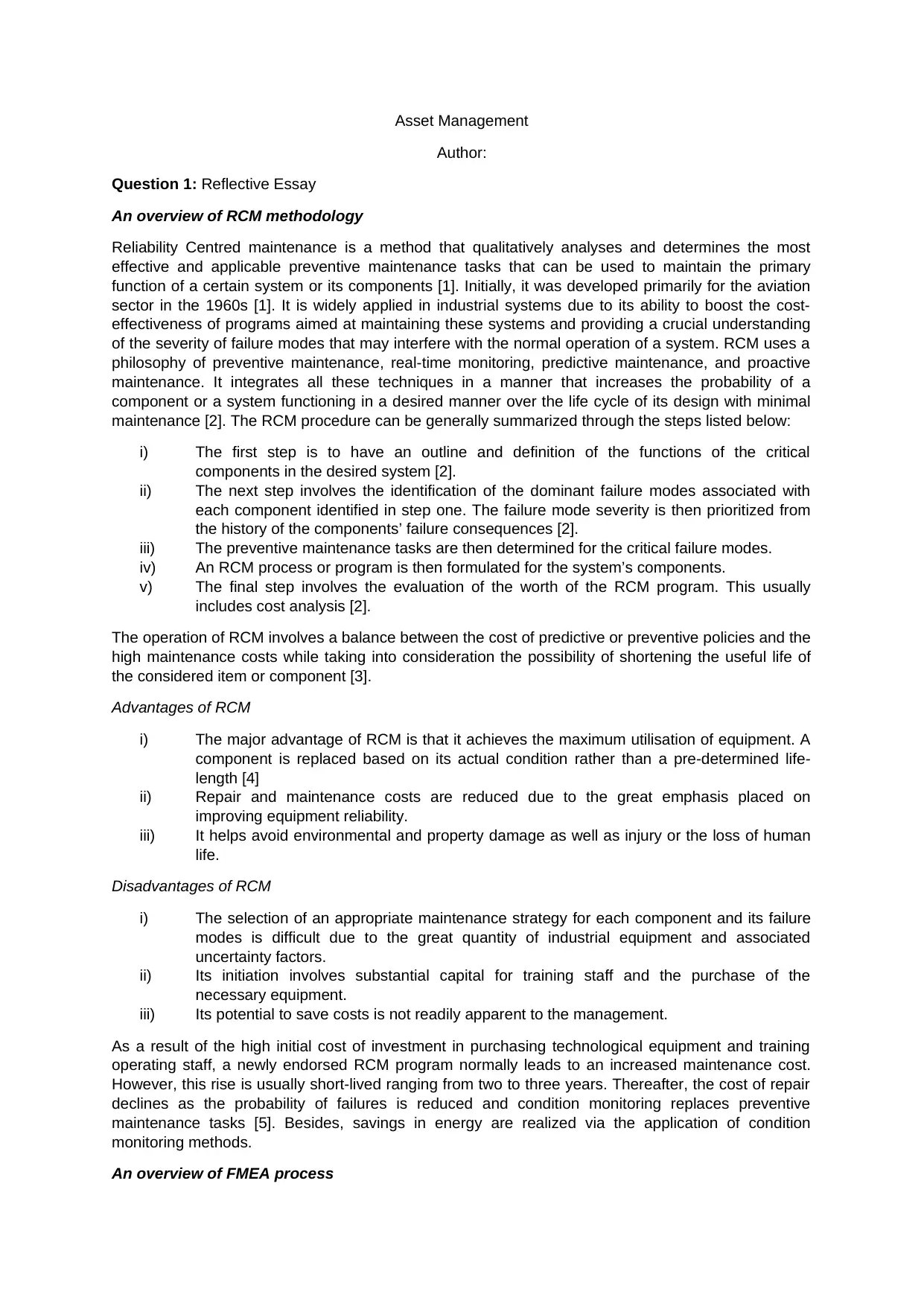
Asset Management
Author:
Question 1: Reflective Essay
An overview of RCM methodology
Reliability Centred maintenance is a method that qualitatively analyses and determines the most
effective and applicable preventive maintenance tasks that can be used to maintain the primary
function of a certain system or its components [1]. Initially, it was developed primarily for the aviation
sector in the 1960s [1]. It is widely applied in industrial systems due to its ability to boost the cost-
effectiveness of programs aimed at maintaining these systems and providing a crucial understanding
of the severity of failure modes that may interfere with the normal operation of a system. RCM uses a
philosophy of preventive maintenance, real-time monitoring, predictive maintenance, and proactive
maintenance. It integrates all these techniques in a manner that increases the probability of a
component or a system functioning in a desired manner over the life cycle of its design with minimal
maintenance [2]. The RCM procedure can be generally summarized through the steps listed below:
i) The first step is to have an outline and definition of the functions of the critical
components in the desired system [2].
ii) The next step involves the identification of the dominant failure modes associated with
each component identified in step one. The failure mode severity is then prioritized from
the history of the components’ failure consequences [2].
iii) The preventive maintenance tasks are then determined for the critical failure modes.
iv) An RCM process or program is then formulated for the system’s components.
v) The final step involves the evaluation of the worth of the RCM program. This usually
includes cost analysis [2].
The operation of RCM involves a balance between the cost of predictive or preventive policies and the
high maintenance costs while taking into consideration the possibility of shortening the useful life of
the considered item or component [3].
Advantages of RCM
i) The major advantage of RCM is that it achieves the maximum utilisation of equipment. A
component is replaced based on its actual condition rather than a pre-determined life-
length [4]
ii) Repair and maintenance costs are reduced due to the great emphasis placed on
improving equipment reliability.
iii) It helps avoid environmental and property damage as well as injury or the loss of human
life.
Disadvantages of RCM
i) The selection of an appropriate maintenance strategy for each component and its failure
modes is difficult due to the great quantity of industrial equipment and associated
uncertainty factors.
ii) Its initiation involves substantial capital for training staff and the purchase of the
necessary equipment.
iii) Its potential to save costs is not readily apparent to the management.
As a result of the high initial cost of investment in purchasing technological equipment and training
operating staff, a newly endorsed RCM program normally leads to an increased maintenance cost.
However, this rise is usually short-lived ranging from two to three years. Thereafter, the cost of repair
declines as the probability of failures is reduced and condition monitoring replaces preventive
maintenance tasks [5]. Besides, savings in energy are realized via the application of condition
monitoring methods.
An overview of FMEA process
Author:
Question 1: Reflective Essay
An overview of RCM methodology
Reliability Centred maintenance is a method that qualitatively analyses and determines the most
effective and applicable preventive maintenance tasks that can be used to maintain the primary
function of a certain system or its components [1]. Initially, it was developed primarily for the aviation
sector in the 1960s [1]. It is widely applied in industrial systems due to its ability to boost the cost-
effectiveness of programs aimed at maintaining these systems and providing a crucial understanding
of the severity of failure modes that may interfere with the normal operation of a system. RCM uses a
philosophy of preventive maintenance, real-time monitoring, predictive maintenance, and proactive
maintenance. It integrates all these techniques in a manner that increases the probability of a
component or a system functioning in a desired manner over the life cycle of its design with minimal
maintenance [2]. The RCM procedure can be generally summarized through the steps listed below:
i) The first step is to have an outline and definition of the functions of the critical
components in the desired system [2].
ii) The next step involves the identification of the dominant failure modes associated with
each component identified in step one. The failure mode severity is then prioritized from
the history of the components’ failure consequences [2].
iii) The preventive maintenance tasks are then determined for the critical failure modes.
iv) An RCM process or program is then formulated for the system’s components.
v) The final step involves the evaluation of the worth of the RCM program. This usually
includes cost analysis [2].
The operation of RCM involves a balance between the cost of predictive or preventive policies and the
high maintenance costs while taking into consideration the possibility of shortening the useful life of
the considered item or component [3].
Advantages of RCM
i) The major advantage of RCM is that it achieves the maximum utilisation of equipment. A
component is replaced based on its actual condition rather than a pre-determined life-
length [4]
ii) Repair and maintenance costs are reduced due to the great emphasis placed on
improving equipment reliability.
iii) It helps avoid environmental and property damage as well as injury or the loss of human
life.
Disadvantages of RCM
i) The selection of an appropriate maintenance strategy for each component and its failure
modes is difficult due to the great quantity of industrial equipment and associated
uncertainty factors.
ii) Its initiation involves substantial capital for training staff and the purchase of the
necessary equipment.
iii) Its potential to save costs is not readily apparent to the management.
As a result of the high initial cost of investment in purchasing technological equipment and training
operating staff, a newly endorsed RCM program normally leads to an increased maintenance cost.
However, this rise is usually short-lived ranging from two to three years. Thereafter, the cost of repair
declines as the probability of failures is reduced and condition monitoring replaces preventive
maintenance tasks [5]. Besides, savings in energy are realized via the application of condition
monitoring methods.
An overview of FMEA process
Paraphrase This Document
Need a fresh take? Get an instant paraphrase of this document with our AI Paraphraser
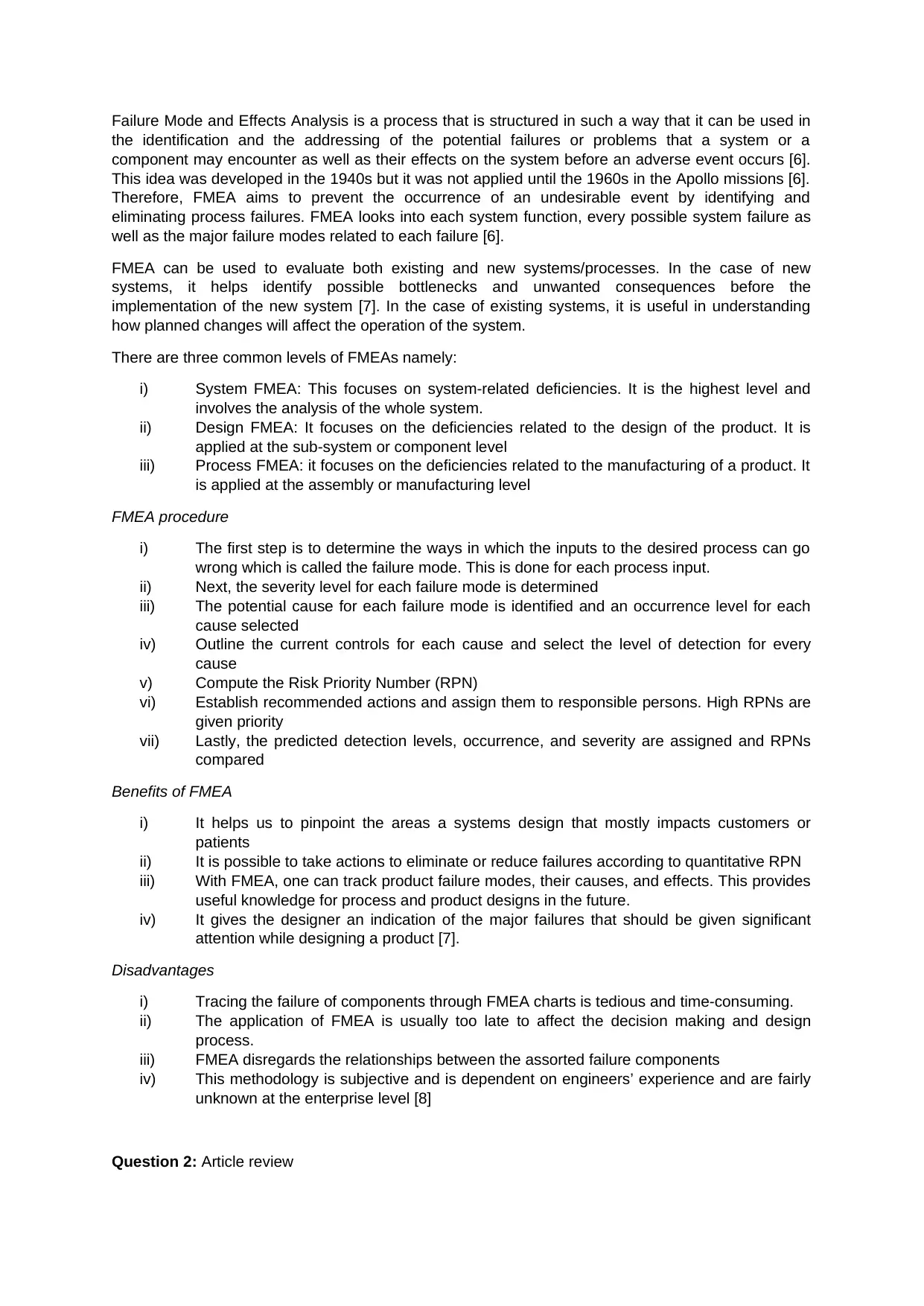
Failure Mode and Effects Analysis is a process that is structured in such a way that it can be used in
the identification and the addressing of the potential failures or problems that a system or a
component may encounter as well as their effects on the system before an adverse event occurs [6].
This idea was developed in the 1940s but it was not applied until the 1960s in the Apollo missions [6].
Therefore, FMEA aims to prevent the occurrence of an undesirable event by identifying and
eliminating process failures. FMEA looks into each system function, every possible system failure as
well as the major failure modes related to each failure [6].
FMEA can be used to evaluate both existing and new systems/processes. In the case of new
systems, it helps identify possible bottlenecks and unwanted consequences before the
implementation of the new system [7]. In the case of existing systems, it is useful in understanding
how planned changes will affect the operation of the system.
There are three common levels of FMEAs namely:
i) System FMEA: This focuses on system-related deficiencies. It is the highest level and
involves the analysis of the whole system.
ii) Design FMEA: It focuses on the deficiencies related to the design of the product. It is
applied at the sub-system or component level
iii) Process FMEA: it focuses on the deficiencies related to the manufacturing of a product. It
is applied at the assembly or manufacturing level
FMEA procedure
i) The first step is to determine the ways in which the inputs to the desired process can go
wrong which is called the failure mode. This is done for each process input.
ii) Next, the severity level for each failure mode is determined
iii) The potential cause for each failure mode is identified and an occurrence level for each
cause selected
iv) Outline the current controls for each cause and select the level of detection for every
cause
v) Compute the Risk Priority Number (RPN)
vi) Establish recommended actions and assign them to responsible persons. High RPNs are
given priority
vii) Lastly, the predicted detection levels, occurrence, and severity are assigned and RPNs
compared
Benefits of FMEA
i) It helps us to pinpoint the areas a systems design that mostly impacts customers or
patients
ii) It is possible to take actions to eliminate or reduce failures according to quantitative RPN
iii) With FMEA, one can track product failure modes, their causes, and effects. This provides
useful knowledge for process and product designs in the future.
iv) It gives the designer an indication of the major failures that should be given significant
attention while designing a product [7].
Disadvantages
i) Tracing the failure of components through FMEA charts is tedious and time-consuming.
ii) The application of FMEA is usually too late to affect the decision making and design
process.
iii) FMEA disregards the relationships between the assorted failure components
iv) This methodology is subjective and is dependent on engineers’ experience and are fairly
unknown at the enterprise level [8]
Question 2: Article review
the identification and the addressing of the potential failures or problems that a system or a
component may encounter as well as their effects on the system before an adverse event occurs [6].
This idea was developed in the 1940s but it was not applied until the 1960s in the Apollo missions [6].
Therefore, FMEA aims to prevent the occurrence of an undesirable event by identifying and
eliminating process failures. FMEA looks into each system function, every possible system failure as
well as the major failure modes related to each failure [6].
FMEA can be used to evaluate both existing and new systems/processes. In the case of new
systems, it helps identify possible bottlenecks and unwanted consequences before the
implementation of the new system [7]. In the case of existing systems, it is useful in understanding
how planned changes will affect the operation of the system.
There are three common levels of FMEAs namely:
i) System FMEA: This focuses on system-related deficiencies. It is the highest level and
involves the analysis of the whole system.
ii) Design FMEA: It focuses on the deficiencies related to the design of the product. It is
applied at the sub-system or component level
iii) Process FMEA: it focuses on the deficiencies related to the manufacturing of a product. It
is applied at the assembly or manufacturing level
FMEA procedure
i) The first step is to determine the ways in which the inputs to the desired process can go
wrong which is called the failure mode. This is done for each process input.
ii) Next, the severity level for each failure mode is determined
iii) The potential cause for each failure mode is identified and an occurrence level for each
cause selected
iv) Outline the current controls for each cause and select the level of detection for every
cause
v) Compute the Risk Priority Number (RPN)
vi) Establish recommended actions and assign them to responsible persons. High RPNs are
given priority
vii) Lastly, the predicted detection levels, occurrence, and severity are assigned and RPNs
compared
Benefits of FMEA
i) It helps us to pinpoint the areas a systems design that mostly impacts customers or
patients
ii) It is possible to take actions to eliminate or reduce failures according to quantitative RPN
iii) With FMEA, one can track product failure modes, their causes, and effects. This provides
useful knowledge for process and product designs in the future.
iv) It gives the designer an indication of the major failures that should be given significant
attention while designing a product [7].
Disadvantages
i) Tracing the failure of components through FMEA charts is tedious and time-consuming.
ii) The application of FMEA is usually too late to affect the decision making and design
process.
iii) FMEA disregards the relationships between the assorted failure components
iv) This methodology is subjective and is dependent on engineers’ experience and are fairly
unknown at the enterprise level [8]
Question 2: Article review
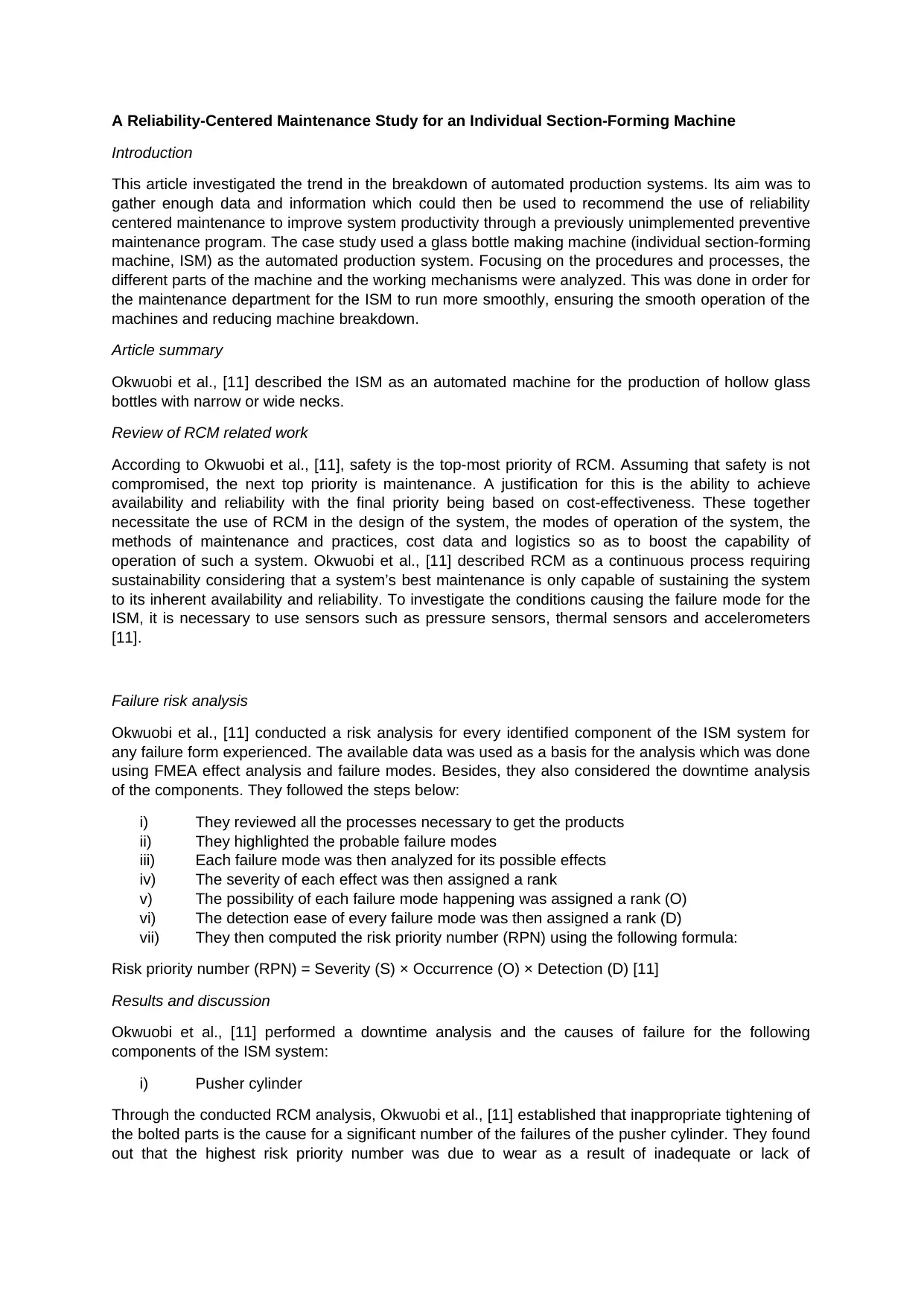
A Reliability-Centered Maintenance Study for an Individual Section-Forming Machine
Introduction
This article investigated the trend in the breakdown of automated production systems. Its aim was to
gather enough data and information which could then be used to recommend the use of reliability
centered maintenance to improve system productivity through a previously unimplemented preventive
maintenance program. The case study used a glass bottle making machine (individual section-forming
machine, ISM) as the automated production system. Focusing on the procedures and processes, the
different parts of the machine and the working mechanisms were analyzed. This was done in order for
the maintenance department for the ISM to run more smoothly, ensuring the smooth operation of the
machines and reducing machine breakdown.
Article summary
Okwuobi et al., [11] described the ISM as an automated machine for the production of hollow glass
bottles with narrow or wide necks.
Review of RCM related work
According to Okwuobi et al., [11], safety is the top-most priority of RCM. Assuming that safety is not
compromised, the next top priority is maintenance. A justification for this is the ability to achieve
availability and reliability with the final priority being based on cost-effectiveness. These together
necessitate the use of RCM in the design of the system, the modes of operation of the system, the
methods of maintenance and practices, cost data and logistics so as to boost the capability of
operation of such a system. Okwuobi et al., [11] described RCM as a continuous process requiring
sustainability considering that a system’s best maintenance is only capable of sustaining the system
to its inherent availability and reliability. To investigate the conditions causing the failure mode for the
ISM, it is necessary to use sensors such as pressure sensors, thermal sensors and accelerometers
[11].
Failure risk analysis
Okwuobi et al., [11] conducted a risk analysis for every identified component of the ISM system for
any failure form experienced. The available data was used as a basis for the analysis which was done
using FMEA effect analysis and failure modes. Besides, they also considered the downtime analysis
of the components. They followed the steps below:
i) They reviewed all the processes necessary to get the products
ii) They highlighted the probable failure modes
iii) Each failure mode was then analyzed for its possible effects
iv) The severity of each effect was then assigned a rank
v) The possibility of each failure mode happening was assigned a rank (O)
vi) The detection ease of every failure mode was then assigned a rank (D)
vii) They then computed the risk priority number (RPN) using the following formula:
Risk priority number (RPN) = Severity (S) × Occurrence (O) × Detection (D) [11]
Results and discussion
Okwuobi et al., [11] performed a downtime analysis and the causes of failure for the following
components of the ISM system:
i) Pusher cylinder
Through the conducted RCM analysis, Okwuobi et al., [11] established that inappropriate tightening of
the bolted parts is the cause for a significant number of the failures of the pusher cylinder. They found
out that the highest risk priority number was due to wear as a result of inadequate or lack of
Introduction
This article investigated the trend in the breakdown of automated production systems. Its aim was to
gather enough data and information which could then be used to recommend the use of reliability
centered maintenance to improve system productivity through a previously unimplemented preventive
maintenance program. The case study used a glass bottle making machine (individual section-forming
machine, ISM) as the automated production system. Focusing on the procedures and processes, the
different parts of the machine and the working mechanisms were analyzed. This was done in order for
the maintenance department for the ISM to run more smoothly, ensuring the smooth operation of the
machines and reducing machine breakdown.
Article summary
Okwuobi et al., [11] described the ISM as an automated machine for the production of hollow glass
bottles with narrow or wide necks.
Review of RCM related work
According to Okwuobi et al., [11], safety is the top-most priority of RCM. Assuming that safety is not
compromised, the next top priority is maintenance. A justification for this is the ability to achieve
availability and reliability with the final priority being based on cost-effectiveness. These together
necessitate the use of RCM in the design of the system, the modes of operation of the system, the
methods of maintenance and practices, cost data and logistics so as to boost the capability of
operation of such a system. Okwuobi et al., [11] described RCM as a continuous process requiring
sustainability considering that a system’s best maintenance is only capable of sustaining the system
to its inherent availability and reliability. To investigate the conditions causing the failure mode for the
ISM, it is necessary to use sensors such as pressure sensors, thermal sensors and accelerometers
[11].
Failure risk analysis
Okwuobi et al., [11] conducted a risk analysis for every identified component of the ISM system for
any failure form experienced. The available data was used as a basis for the analysis which was done
using FMEA effect analysis and failure modes. Besides, they also considered the downtime analysis
of the components. They followed the steps below:
i) They reviewed all the processes necessary to get the products
ii) They highlighted the probable failure modes
iii) Each failure mode was then analyzed for its possible effects
iv) The severity of each effect was then assigned a rank
v) The possibility of each failure mode happening was assigned a rank (O)
vi) The detection ease of every failure mode was then assigned a rank (D)
vii) They then computed the risk priority number (RPN) using the following formula:
Risk priority number (RPN) = Severity (S) × Occurrence (O) × Detection (D) [11]
Results and discussion
Okwuobi et al., [11] performed a downtime analysis and the causes of failure for the following
components of the ISM system:
i) Pusher cylinder
Through the conducted RCM analysis, Okwuobi et al., [11] established that inappropriate tightening of
the bolted parts is the cause for a significant number of the failures of the pusher cylinder. They found
out that the highest risk priority number was due to wear as a result of inadequate or lack of
⊘ This is a preview!⊘
Do you want full access?
Subscribe today to unlock all pages.

Trusted by 1+ million students worldwide
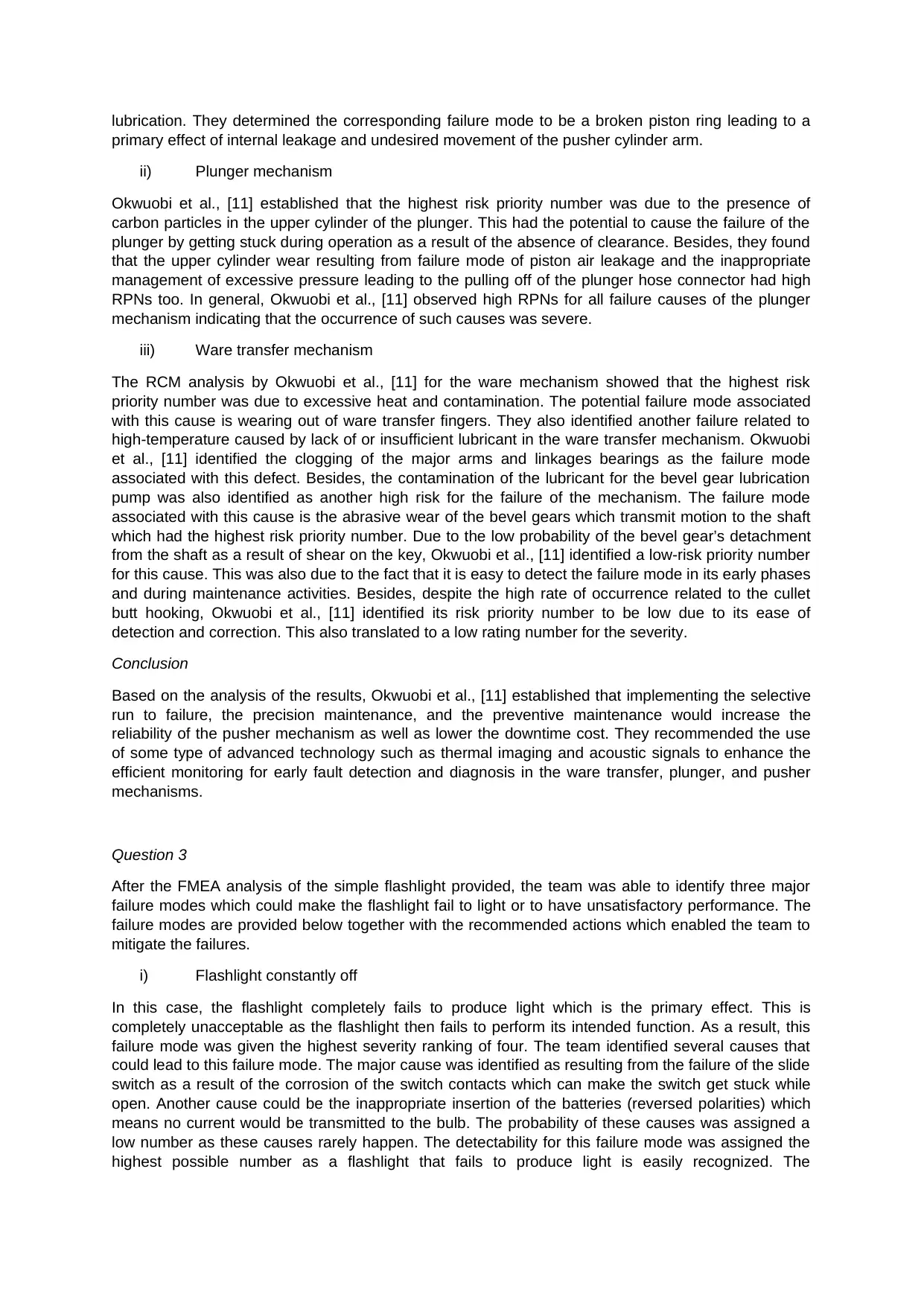
lubrication. They determined the corresponding failure mode to be a broken piston ring leading to a
primary effect of internal leakage and undesired movement of the pusher cylinder arm.
ii) Plunger mechanism
Okwuobi et al., [11] established that the highest risk priority number was due to the presence of
carbon particles in the upper cylinder of the plunger. This had the potential to cause the failure of the
plunger by getting stuck during operation as a result of the absence of clearance. Besides, they found
that the upper cylinder wear resulting from failure mode of piston air leakage and the inappropriate
management of excessive pressure leading to the pulling off of the plunger hose connector had high
RPNs too. In general, Okwuobi et al., [11] observed high RPNs for all failure causes of the plunger
mechanism indicating that the occurrence of such causes was severe.
iii) Ware transfer mechanism
The RCM analysis by Okwuobi et al., [11] for the ware mechanism showed that the highest risk
priority number was due to excessive heat and contamination. The potential failure mode associated
with this cause is wearing out of ware transfer fingers. They also identified another failure related to
high-temperature caused by lack of or insufficient lubricant in the ware transfer mechanism. Okwuobi
et al., [11] identified the clogging of the major arms and linkages bearings as the failure mode
associated with this defect. Besides, the contamination of the lubricant for the bevel gear lubrication
pump was also identified as another high risk for the failure of the mechanism. The failure mode
associated with this cause is the abrasive wear of the bevel gears which transmit motion to the shaft
which had the highest risk priority number. Due to the low probability of the bevel gear’s detachment
from the shaft as a result of shear on the key, Okwuobi et al., [11] identified a low-risk priority number
for this cause. This was also due to the fact that it is easy to detect the failure mode in its early phases
and during maintenance activities. Besides, despite the high rate of occurrence related to the cullet
butt hooking, Okwuobi et al., [11] identified its risk priority number to be low due to its ease of
detection and correction. This also translated to a low rating number for the severity.
Conclusion
Based on the analysis of the results, Okwuobi et al., [11] established that implementing the selective
run to failure, the precision maintenance, and the preventive maintenance would increase the
reliability of the pusher mechanism as well as lower the downtime cost. They recommended the use
of some type of advanced technology such as thermal imaging and acoustic signals to enhance the
efficient monitoring for early fault detection and diagnosis in the ware transfer, plunger, and pusher
mechanisms.
Question 3
After the FMEA analysis of the simple flashlight provided, the team was able to identify three major
failure modes which could make the flashlight fail to light or to have unsatisfactory performance. The
failure modes are provided below together with the recommended actions which enabled the team to
mitigate the failures.
i) Flashlight constantly off
In this case, the flashlight completely fails to produce light which is the primary effect. This is
completely unacceptable as the flashlight then fails to perform its intended function. As a result, this
failure mode was given the highest severity ranking of four. The team identified several causes that
could lead to this failure mode. The major cause was identified as resulting from the failure of the slide
switch as a result of the corrosion of the switch contacts which can make the switch get stuck while
open. Another cause could be the inappropriate insertion of the batteries (reversed polarities) which
means no current would be transmitted to the bulb. The probability of these causes was assigned a
low number as these causes rarely happen. The detectability for this failure mode was assigned the
highest possible number as a flashlight that fails to produce light is easily recognized. The
primary effect of internal leakage and undesired movement of the pusher cylinder arm.
ii) Plunger mechanism
Okwuobi et al., [11] established that the highest risk priority number was due to the presence of
carbon particles in the upper cylinder of the plunger. This had the potential to cause the failure of the
plunger by getting stuck during operation as a result of the absence of clearance. Besides, they found
that the upper cylinder wear resulting from failure mode of piston air leakage and the inappropriate
management of excessive pressure leading to the pulling off of the plunger hose connector had high
RPNs too. In general, Okwuobi et al., [11] observed high RPNs for all failure causes of the plunger
mechanism indicating that the occurrence of such causes was severe.
iii) Ware transfer mechanism
The RCM analysis by Okwuobi et al., [11] for the ware mechanism showed that the highest risk
priority number was due to excessive heat and contamination. The potential failure mode associated
with this cause is wearing out of ware transfer fingers. They also identified another failure related to
high-temperature caused by lack of or insufficient lubricant in the ware transfer mechanism. Okwuobi
et al., [11] identified the clogging of the major arms and linkages bearings as the failure mode
associated with this defect. Besides, the contamination of the lubricant for the bevel gear lubrication
pump was also identified as another high risk for the failure of the mechanism. The failure mode
associated with this cause is the abrasive wear of the bevel gears which transmit motion to the shaft
which had the highest risk priority number. Due to the low probability of the bevel gear’s detachment
from the shaft as a result of shear on the key, Okwuobi et al., [11] identified a low-risk priority number
for this cause. This was also due to the fact that it is easy to detect the failure mode in its early phases
and during maintenance activities. Besides, despite the high rate of occurrence related to the cullet
butt hooking, Okwuobi et al., [11] identified its risk priority number to be low due to its ease of
detection and correction. This also translated to a low rating number for the severity.
Conclusion
Based on the analysis of the results, Okwuobi et al., [11] established that implementing the selective
run to failure, the precision maintenance, and the preventive maintenance would increase the
reliability of the pusher mechanism as well as lower the downtime cost. They recommended the use
of some type of advanced technology such as thermal imaging and acoustic signals to enhance the
efficient monitoring for early fault detection and diagnosis in the ware transfer, plunger, and pusher
mechanisms.
Question 3
After the FMEA analysis of the simple flashlight provided, the team was able to identify three major
failure modes which could make the flashlight fail to light or to have unsatisfactory performance. The
failure modes are provided below together with the recommended actions which enabled the team to
mitigate the failures.
i) Flashlight constantly off
In this case, the flashlight completely fails to produce light which is the primary effect. This is
completely unacceptable as the flashlight then fails to perform its intended function. As a result, this
failure mode was given the highest severity ranking of four. The team identified several causes that
could lead to this failure mode. The major cause was identified as resulting from the failure of the slide
switch as a result of the corrosion of the switch contacts which can make the switch get stuck while
open. Another cause could be the inappropriate insertion of the batteries (reversed polarities) which
means no current would be transmitted to the bulb. The probability of these causes was assigned a
low number as these causes rarely happen. The detectability for this failure mode was assigned the
highest possible number as a flashlight that fails to produce light is easily recognized. The
Paraphrase This Document
Need a fresh take? Get an instant paraphrase of this document with our AI Paraphraser
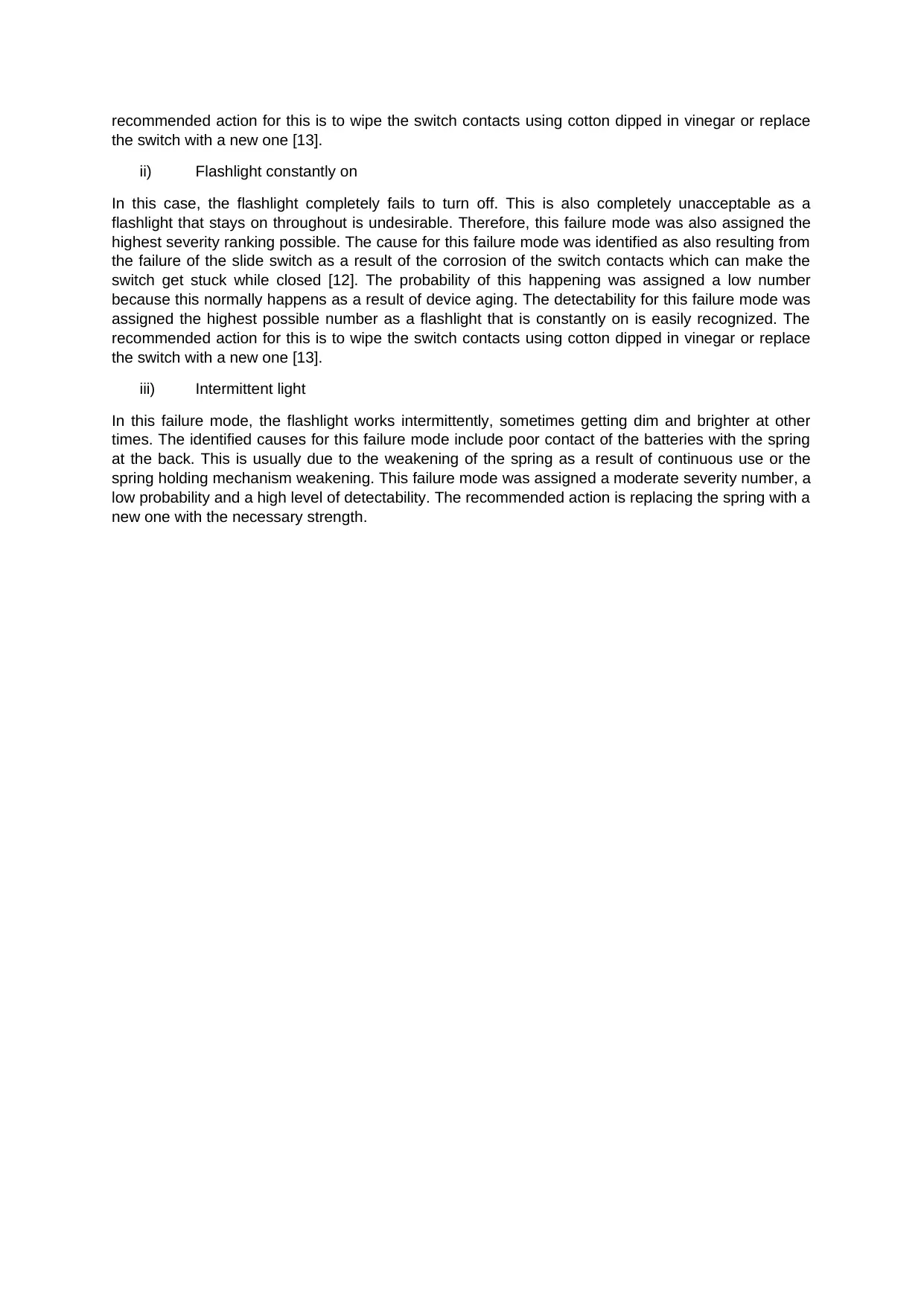
recommended action for this is to wipe the switch contacts using cotton dipped in vinegar or replace
the switch with a new one [13].
ii) Flashlight constantly on
In this case, the flashlight completely fails to turn off. This is also completely unacceptable as a
flashlight that stays on throughout is undesirable. Therefore, this failure mode was also assigned the
highest severity ranking possible. The cause for this failure mode was identified as also resulting from
the failure of the slide switch as a result of the corrosion of the switch contacts which can make the
switch get stuck while closed [12]. The probability of this happening was assigned a low number
because this normally happens as a result of device aging. The detectability for this failure mode was
assigned the highest possible number as a flashlight that is constantly on is easily recognized. The
recommended action for this is to wipe the switch contacts using cotton dipped in vinegar or replace
the switch with a new one [13].
iii) Intermittent light
In this failure mode, the flashlight works intermittently, sometimes getting dim and brighter at other
times. The identified causes for this failure mode include poor contact of the batteries with the spring
at the back. This is usually due to the weakening of the spring as a result of continuous use or the
spring holding mechanism weakening. This failure mode was assigned a moderate severity number, a
low probability and a high level of detectability. The recommended action is replacing the spring with a
new one with the necessary strength.
the switch with a new one [13].
ii) Flashlight constantly on
In this case, the flashlight completely fails to turn off. This is also completely unacceptable as a
flashlight that stays on throughout is undesirable. Therefore, this failure mode was also assigned the
highest severity ranking possible. The cause for this failure mode was identified as also resulting from
the failure of the slide switch as a result of the corrosion of the switch contacts which can make the
switch get stuck while closed [12]. The probability of this happening was assigned a low number
because this normally happens as a result of device aging. The detectability for this failure mode was
assigned the highest possible number as a flashlight that is constantly on is easily recognized. The
recommended action for this is to wipe the switch contacts using cotton dipped in vinegar or replace
the switch with a new one [13].
iii) Intermittent light
In this failure mode, the flashlight works intermittently, sometimes getting dim and brighter at other
times. The identified causes for this failure mode include poor contact of the batteries with the spring
at the back. This is usually due to the weakening of the spring as a result of continuous use or the
spring holding mechanism weakening. This failure mode was assigned a moderate severity number, a
low probability and a high level of detectability. The recommended action is replacing the spring with a
new one with the necessary strength.
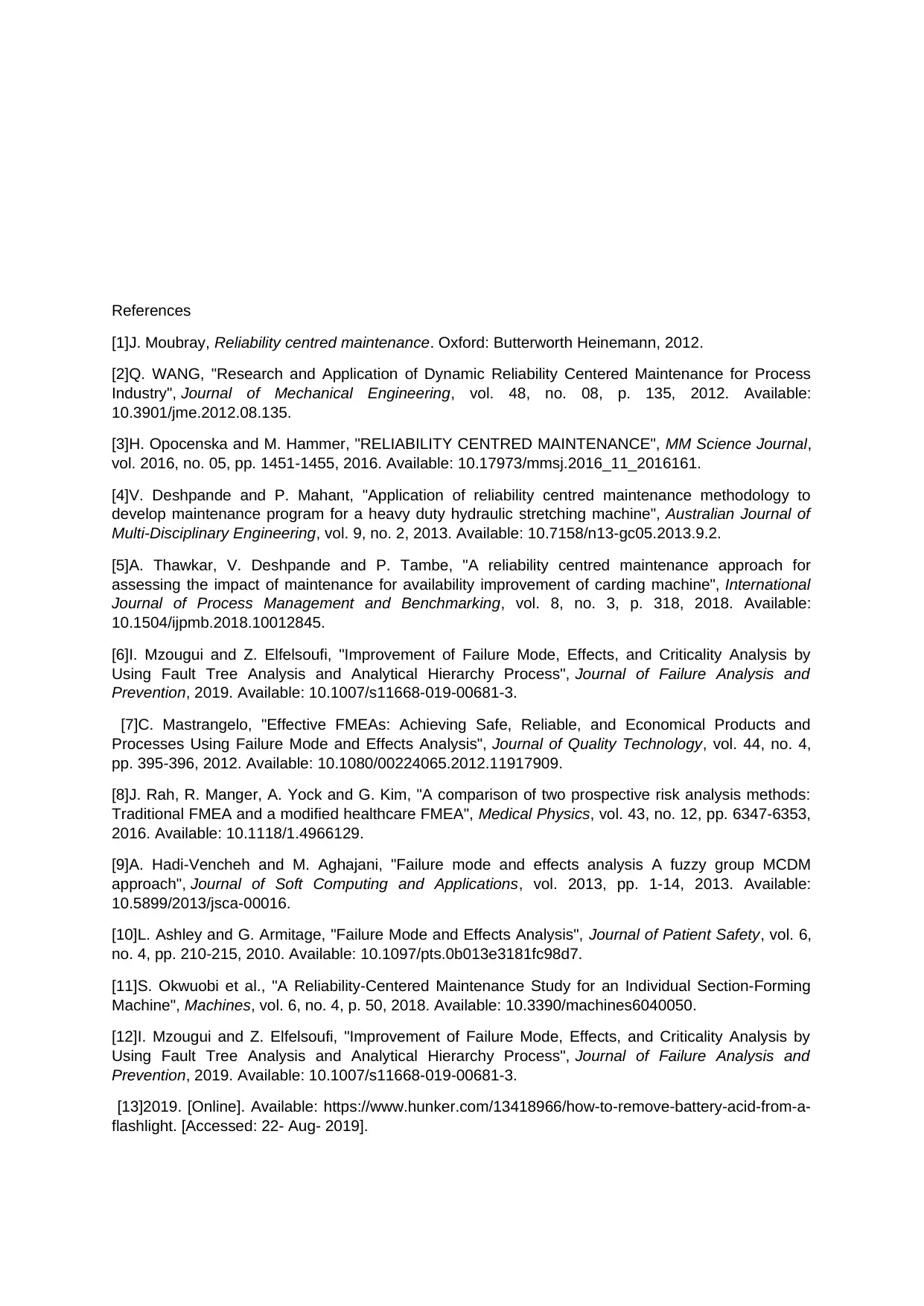
References
[1]J. Moubray, Reliability centred maintenance. Oxford: Butterworth Heinemann, 2012.
[2]Q. WANG, "Research and Application of Dynamic Reliability Centered Maintenance for Process
Industry", Journal of Mechanical Engineering, vol. 48, no. 08, p. 135, 2012. Available:
10.3901/jme.2012.08.135.
[3]H. Opocenska and M. Hammer, "RELIABILITY CENTRED MAINTENANCE", MM Science Journal,
vol. 2016, no. 05, pp. 1451-1455, 2016. Available: 10.17973/mmsj.2016_11_2016161.
[4]V. Deshpande and P. Mahant, "Application of reliability centred maintenance methodology to
develop maintenance program for a heavy duty hydraulic stretching machine", Australian Journal of
Multi-Disciplinary Engineering, vol. 9, no. 2, 2013. Available: 10.7158/n13-gc05.2013.9.2.
[5]A. Thawkar, V. Deshpande and P. Tambe, "A reliability centred maintenance approach for
assessing the impact of maintenance for availability improvement of carding machine", International
Journal of Process Management and Benchmarking, vol. 8, no. 3, p. 318, 2018. Available:
10.1504/ijpmb.2018.10012845.
[6]I. Mzougui and Z. Elfelsoufi, "Improvement of Failure Mode, Effects, and Criticality Analysis by
Using Fault Tree Analysis and Analytical Hierarchy Process", Journal of Failure Analysis and
Prevention, 2019. Available: 10.1007/s11668-019-00681-3.
[7]C. Mastrangelo, "Effective FMEAs: Achieving Safe, Reliable, and Economical Products and
Processes Using Failure Mode and Effects Analysis", Journal of Quality Technology, vol. 44, no. 4,
pp. 395-396, 2012. Available: 10.1080/00224065.2012.11917909.
[8]J. Rah, R. Manger, A. Yock and G. Kim, "A comparison of two prospective risk analysis methods:
Traditional FMEA and a modified healthcare FMEA", Medical Physics, vol. 43, no. 12, pp. 6347-6353,
2016. Available: 10.1118/1.4966129.
[9]A. Hadi-Vencheh and M. Aghajani, "Failure mode and effects analysis A fuzzy group MCDM
approach", Journal of Soft Computing and Applications, vol. 2013, pp. 1-14, 2013. Available:
10.5899/2013/jsca-00016.
[10]L. Ashley and G. Armitage, "Failure Mode and Effects Analysis", Journal of Patient Safety, vol. 6,
no. 4, pp. 210-215, 2010. Available: 10.1097/pts.0b013e3181fc98d7.
[11]S. Okwuobi et al., "A Reliability-Centered Maintenance Study for an Individual Section-Forming
Machine", Machines, vol. 6, no. 4, p. 50, 2018. Available: 10.3390/machines6040050.
[12]I. Mzougui and Z. Elfelsoufi, "Improvement of Failure Mode, Effects, and Criticality Analysis by
Using Fault Tree Analysis and Analytical Hierarchy Process", Journal of Failure Analysis and
Prevention, 2019. Available: 10.1007/s11668-019-00681-3.
[13]2019. [Online]. Available: https://www.hunker.com/13418966/how-to-remove-battery-acid-from-a-
flashlight. [Accessed: 22- Aug- 2019].
[1]J. Moubray, Reliability centred maintenance. Oxford: Butterworth Heinemann, 2012.
[2]Q. WANG, "Research and Application of Dynamic Reliability Centered Maintenance for Process
Industry", Journal of Mechanical Engineering, vol. 48, no. 08, p. 135, 2012. Available:
10.3901/jme.2012.08.135.
[3]H. Opocenska and M. Hammer, "RELIABILITY CENTRED MAINTENANCE", MM Science Journal,
vol. 2016, no. 05, pp. 1451-1455, 2016. Available: 10.17973/mmsj.2016_11_2016161.
[4]V. Deshpande and P. Mahant, "Application of reliability centred maintenance methodology to
develop maintenance program for a heavy duty hydraulic stretching machine", Australian Journal of
Multi-Disciplinary Engineering, vol. 9, no. 2, 2013. Available: 10.7158/n13-gc05.2013.9.2.
[5]A. Thawkar, V. Deshpande and P. Tambe, "A reliability centred maintenance approach for
assessing the impact of maintenance for availability improvement of carding machine", International
Journal of Process Management and Benchmarking, vol. 8, no. 3, p. 318, 2018. Available:
10.1504/ijpmb.2018.10012845.
[6]I. Mzougui and Z. Elfelsoufi, "Improvement of Failure Mode, Effects, and Criticality Analysis by
Using Fault Tree Analysis and Analytical Hierarchy Process", Journal of Failure Analysis and
Prevention, 2019. Available: 10.1007/s11668-019-00681-3.
[7]C. Mastrangelo, "Effective FMEAs: Achieving Safe, Reliable, and Economical Products and
Processes Using Failure Mode and Effects Analysis", Journal of Quality Technology, vol. 44, no. 4,
pp. 395-396, 2012. Available: 10.1080/00224065.2012.11917909.
[8]J. Rah, R. Manger, A. Yock and G. Kim, "A comparison of two prospective risk analysis methods:
Traditional FMEA and a modified healthcare FMEA", Medical Physics, vol. 43, no. 12, pp. 6347-6353,
2016. Available: 10.1118/1.4966129.
[9]A. Hadi-Vencheh and M. Aghajani, "Failure mode and effects analysis A fuzzy group MCDM
approach", Journal of Soft Computing and Applications, vol. 2013, pp. 1-14, 2013. Available:
10.5899/2013/jsca-00016.
[10]L. Ashley and G. Armitage, "Failure Mode and Effects Analysis", Journal of Patient Safety, vol. 6,
no. 4, pp. 210-215, 2010. Available: 10.1097/pts.0b013e3181fc98d7.
[11]S. Okwuobi et al., "A Reliability-Centered Maintenance Study for an Individual Section-Forming
Machine", Machines, vol. 6, no. 4, p. 50, 2018. Available: 10.3390/machines6040050.
[12]I. Mzougui and Z. Elfelsoufi, "Improvement of Failure Mode, Effects, and Criticality Analysis by
Using Fault Tree Analysis and Analytical Hierarchy Process", Journal of Failure Analysis and
Prevention, 2019. Available: 10.1007/s11668-019-00681-3.
[13]2019. [Online]. Available: https://www.hunker.com/13418966/how-to-remove-battery-acid-from-a-
flashlight. [Accessed: 22- Aug- 2019].
⊘ This is a preview!⊘
Do you want full access?
Subscribe today to unlock all pages.

Trusted by 1+ million students worldwide
1 out of 6
Related Documents
Your All-in-One AI-Powered Toolkit for Academic Success.
+13062052269
info@desklib.com
Available 24*7 on WhatsApp / Email
![[object Object]](/_next/static/media/star-bottom.7253800d.svg)
Unlock your academic potential
Copyright © 2020–2025 A2Z Services. All Rights Reserved. Developed and managed by ZUCOL.





